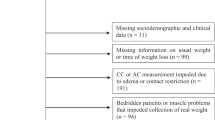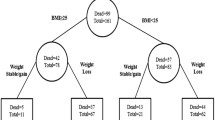Abstract
The objectives of this prospective observational study were to assess whether: 1) midarm circumference (MAC), previously shown to predict in-hospital mortality, maintains its prognostic implication after discharge; 2) in-hospital changes in aspecific indicators of the health status are predictors of long-term survival. The study population consisted of 249 patients from the general community [mean age 80±7 (70–99) years], consecutively discharged from geriatric and medical wards of an acute care hospital. Changes in health status during hospitalization were recorded (dynamic or δ variables) and health-related variables were collected at discharge (discharge variables). The relationship of both sets of variables to survival over a 3-year period was assessed by Cox’s proportional hazards regression analysis. The discriminatory efficacy of predictive models was estimated by the Hanley and McNeil method. Survival curves were drawn with the patients alternatively grouped according to the presence or absence of each of the predictive variables. Serum albumin<3.5 g/dL (hazard rate=0.57, 95% confidence limits=0.33–0.96) and dependency in at least one ADL (h.r.=0.87, c.l.=0.79–0.98) were found to be associated with increased mortality, and δMAC (h.r.=1.03, c.l.=1.01−1.05 ), i.e., there was a positive change or no change in MAC from admission to discharge, with increased survival. A slightly weaker predictive model was obtained using only discharge variables. However, Hanley and McNeil’s analysis showed that both models were far from achieving the optimal discrimination of high from low risk subjects. Effects on survival of individual variables varied in magnitude and dependency on time. We concluded that measuring inhospital changes in nutritional status might improve prediction of long-term survival. Attempts should be made to identify variables having the strongest prognostic implications, and to tailor dynamic assessment to the needs of selected categories of patients.
Similar content being viewed by others
References
Cohen H.J., Feussner J.R.: Comprehensive geriatric assessment: Mission not yet accomplished. J. Gerontol. 44: M175–M177, 1989.
Stuck A.E., Siu A.L., Wieland G.D., Adams J., Rubenstein L.Z.: Comprehensive geriatric assessment: A meta-analysis of controlled trials. Lancet 342: 1032–1036, 1993.
Sullivan D.H., Patch G.A., Walls R.C., Lipschitz D.A.: Impact of nutrition status on morbidity and mortality in a select population of geriatric patients. Am. J. Clin. Nutr. 51: 749–758, 1990.
Sullivan D.H., Walls R.C., Lipschitz D.A.: Protein-energy malnutrition and the risk of mortality within 1 y of hospital discharge in a select population of geriatric rehabilitation patients. Am. J. Clin. Nutr. 53: 599–605, 1991.
Antonelli Incalzi R., Landi F., Cipriani L., Bruno E., Pagano F., Gemma A., Capparella O., Carbonin P.U.: Nutritional assessment: a primary component of multidimensional geriatric assesment in the acute care setting. J. Am. Geriatr. Soc. 44: 166–174, 1996.
Exton-Smith A.N.: Epidemiological studies in the elderly: methodological considerations. Am. J. Clin. Nutr. 35: 1273–1279, 1982.
Grahame R.: A method for measuring human skin elasticity in vivo with observations on the effects of age, sex and pregnancy. Clin. Sci. 39: 223–238, 1970.
Chumlea W.C., Roche A.F., Webb P.: Body size, subcutaneous fatness and total body fat in the elderly. Int. J. Obes. 8: 311–318, 1984.
Antonelli Incalzi R., Gemma A., Capparella O., Cipriani L., Landi F., Carbonin P.U.: Energy intake and in-hospital starvation: a clinically relevant relationship. Arch. Intern. Med. 156: 425–429, 1996.
Antonelli Incalzi R., Capparella O., Gemma A., Landi F., Pagano F., Cipriani L., Carbonin P.U.: Inadequate caloric intake: a risk factor for mortality of geriatric patients in the acute care hospital. Age Ageing 27: 303–310, 1998.
Steinbaugh M.L., Chumlea W.C., Guo S.: Estimating body weight for the non ambulatory elderly. Abstracted American Dietetic Association 69th Annual Meeting, Las Vegas, NV, October 1986.
Chumlea W.C., Roche A.F., Steinbaugh M.L.: Estimating stature from knee height for persons 65 to 90 years of age. J. Am. Geriatr. Soc. 33: 116–120, 1985.
Charlson M.E., Ales K.A., Pompei P., MacKenzie C.R.: A new method of classifying prognostic comorbidity in longitudinal studies: development and validation. J. Chronic Dis. 40: 373–383, 1987.
Hopkins A.: Survival analysis with covariates — Cox models. In: Dixon W.J. (Ed.), BMDP Statistical Software Manual. University of California Press, Berkeley, CA, 1988, pp. 719–743.
Hanley J.A., McNeil B.: Maximum obtainable discrimination and the utilization of radiologic examination. J. Chronic Dis. 35: 601–611, 1982.
Benedetti J., Yuen K., Young L.: Life tables and survivor functions. In: Dixon W.J. (Ed.), BMDP Statistical Software Manual. University of California Press, Berkeley, CA, 1988, pp 689–718.
Reiff T.B.: Body composition with special reference to water. In: Horwitz A. (Ed.), Nutrition in the Elderly. Oxford University Press, Oxford, 1989, pp. 115–122.
Wright S.: Applied Physiology. Oxford University Press, London, 1971, pp. 13–14.
Munro H.N., Young V.R.: Urinary excretion of N-methylisti-dine (3-methylhistidine): A tool to study metabolic responses in relation to nutrient and hormonal status in health and disease in man. Am. J. Clin. Nutr. 31: 1608–1614, 1978.
Fanelli M.T.: The ABC’s of nutritional assessment in the older adults. J. Nutr. Elderly 6: 33–40, 1987.
Corti M.C., Guralnik J.M., Salive M.E., Sorkin J.D.: Serum albumin level and physical disability as predictors of mortality in older persons. JAMA 272: 1035–1042, 1994.
Antonelli Incalzi R., Capparella O., Gemma A., Porcedda P., Raccis G., Sommella L., Carbonin P.U.: A simple method of recognizing geriatric patients at risk for death and disability. J. Am. Geriatr. Soc. 40: 34–38, 1992.
Wolf-Klein G.P., Silverstone F.A.: Weight loss in Alzheimer’s disease: an international review of the literature. Int. Psychogeriatr. 6: 135–142, 1994.
Wilson D.O., Rogers R.M., Wright E.C., Anthonisen N.R.: Body weight in chronic obstructive pulmonary disease: The National Institutes of Health intermittent positive-pressure breathing trial. Am. Rev. Respir. Dis. 139: 1435–1438, 1989.
Solomon D.H.: Geriatric assessment: Methods for clinical decision making. JAMA 259: 2450–2452, 1988.
Fretwell M.: The Consensus Conference on Comprehensive Geriatric Assessment: A dialogue is beginning of consensus J. Am. Geriatr. Soc. 36: 377–379, 1988 (Editorial).
Author information
Authors and Affiliations
Rights and permissions
About this article
Cite this article
Incalzi, R.A., Landi, F., Pagano, F. et al. Changes in nutritional status during the hospital stay: A predictor of long-term survival. Aging Clin Exp Res 10, 490–496 (1998). https://doi.org/10.1007/BF03340163
Received:
Accepted:
Published:
Issue Date:
DOI: https://doi.org/10.1007/BF03340163




